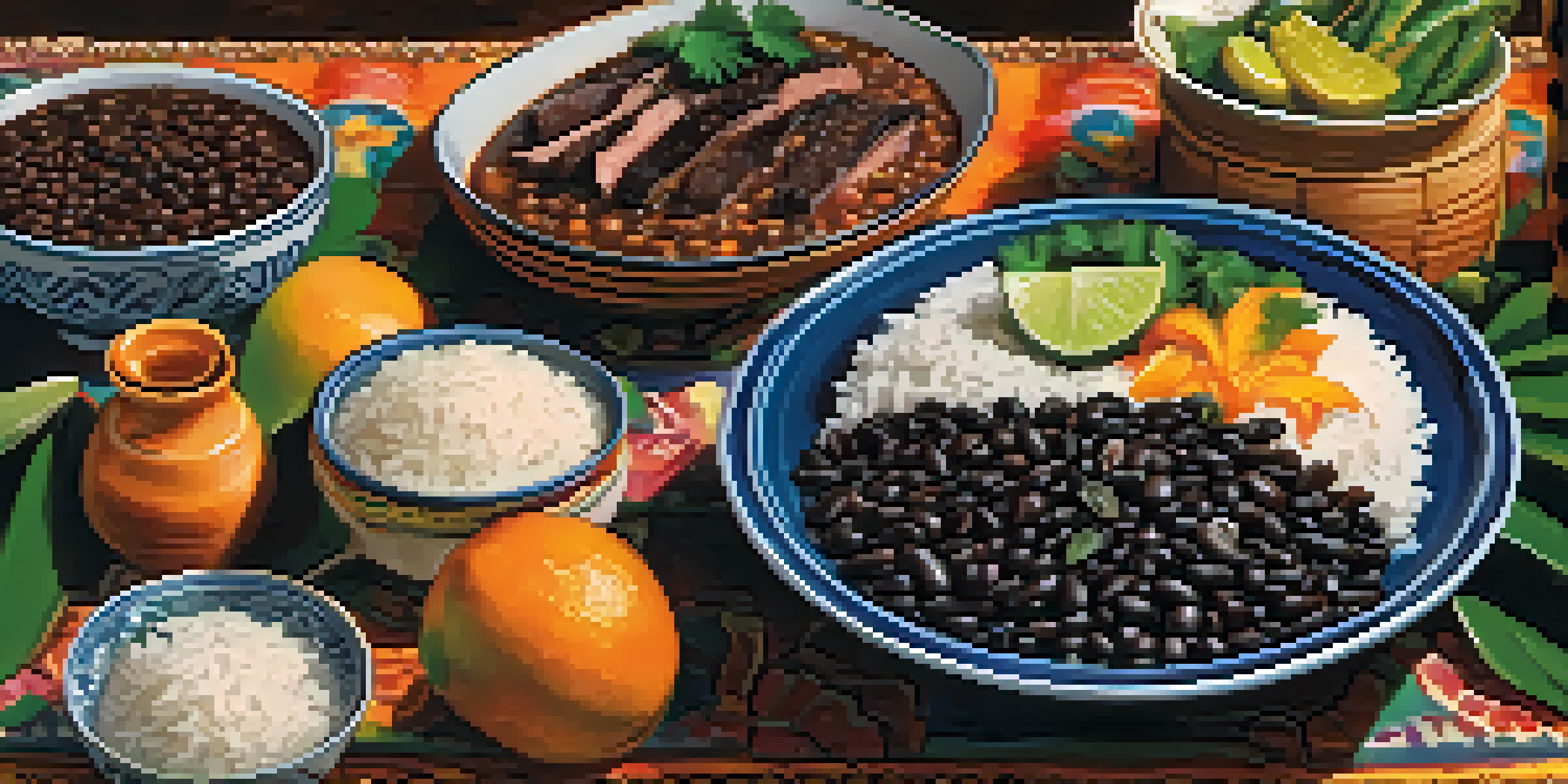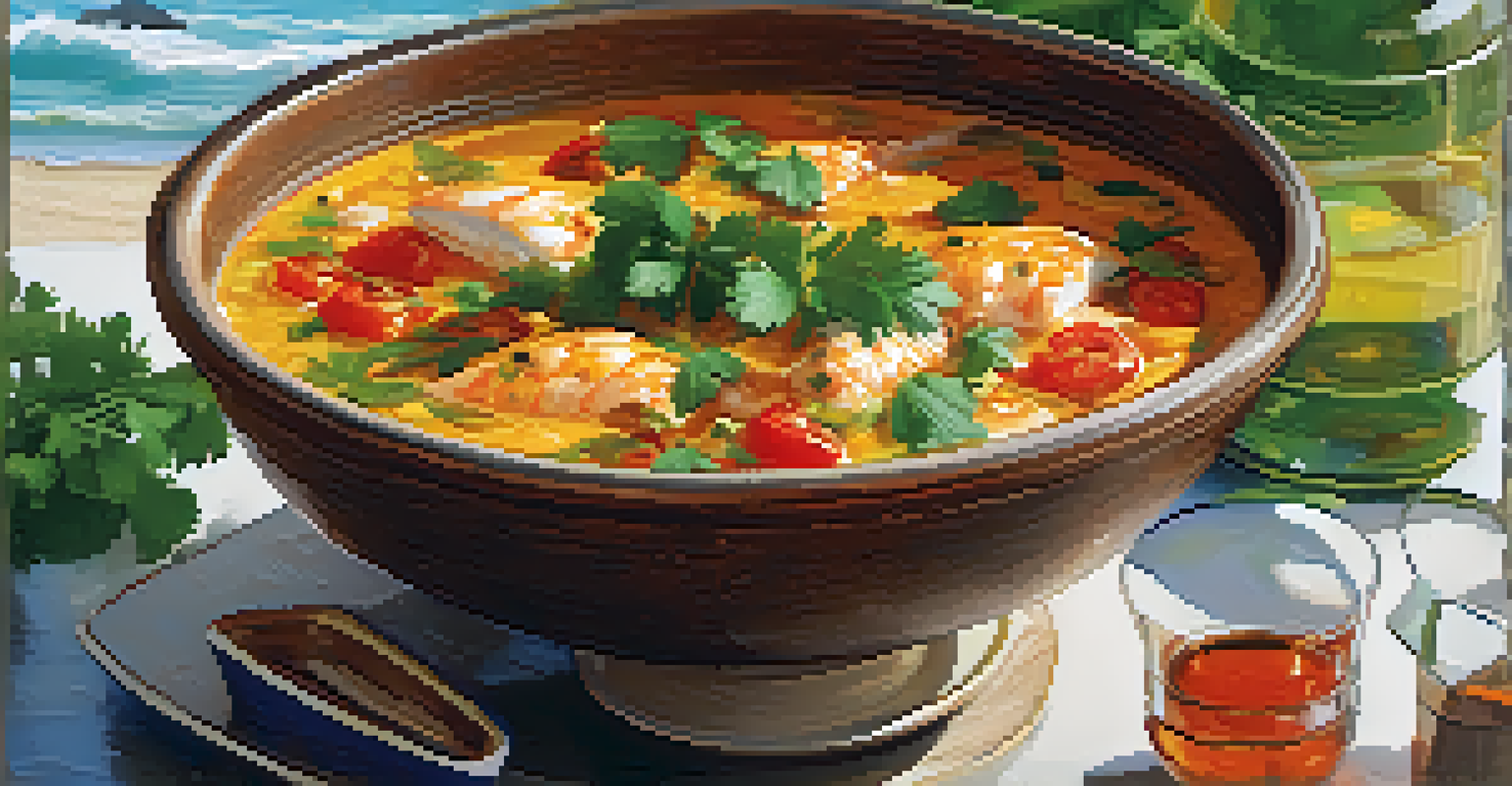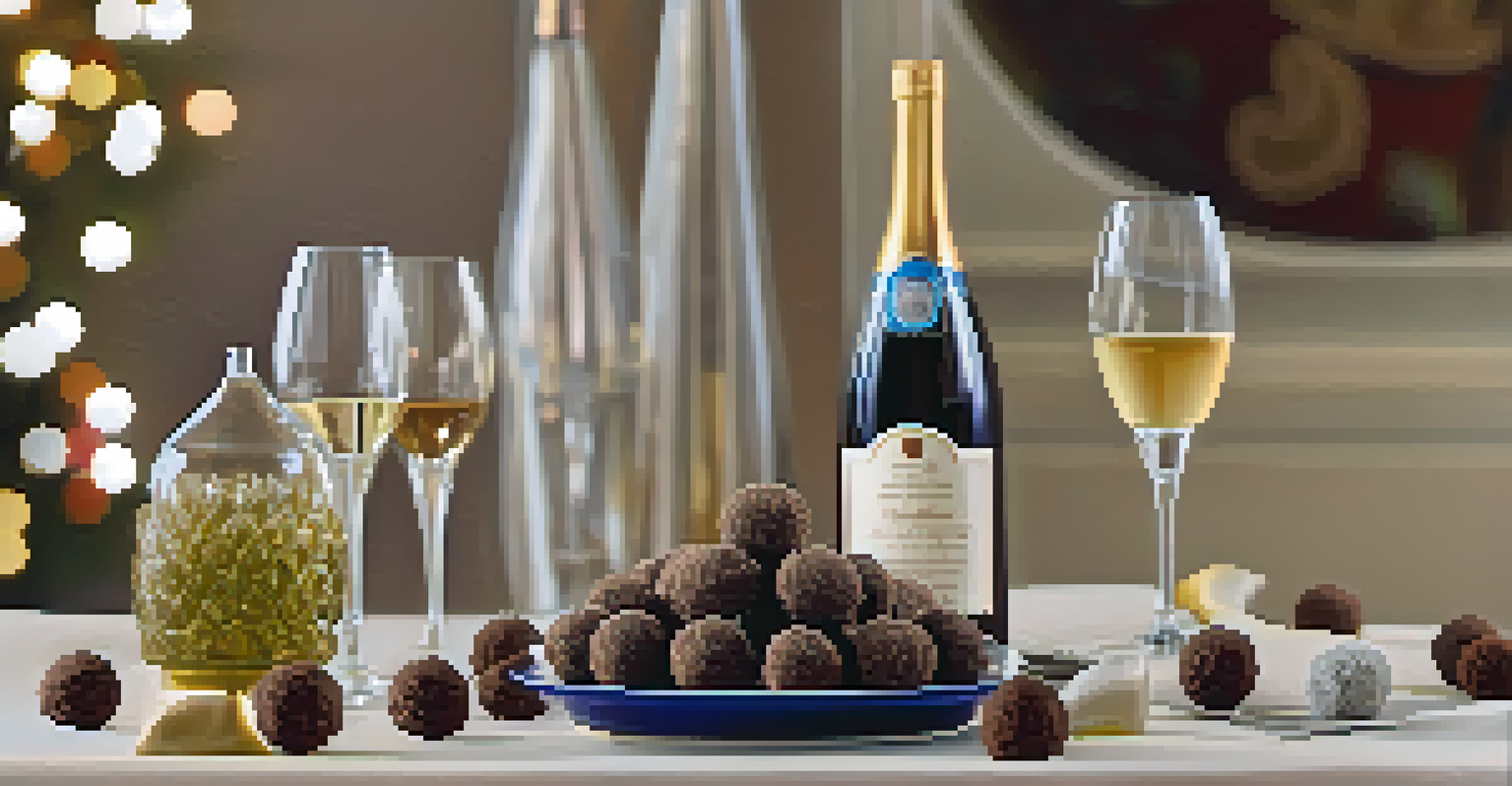Pairing Brazilian Cuisine with Local Wines: A Culinary Guide

Exploring the Richness of Brazilian Cuisine
Brazilian cuisine is a vibrant tapestry of flavors, textures, and ingredients, influenced by indigenous cultures, African traditions, and European colonization. From the hearty feijoada, a black bean stew, to the refreshing acarajé, a deep-fried ball of black-eyed pea dough, each dish tells a story of Brazil's rich culinary heritage. The use of fresh ingredients, such as tropical fruits and locally sourced meats, adds to the distinctiveness that makes Brazilian food a delight to experience.
Food is the ingredient that binds us together.
One of the most exciting aspects of Brazilian cuisine is how regional variations contribute to its diversity. For instance, the Amazon region boasts exotic fish and fruits, while the southern states are known for their barbecue and chimichurri sauces. This regional charm is what makes pairing Brazilian dishes with local wines such a rewarding adventure—there’s always a new flavor combination waiting to be discovered.
As we venture deeper into the world of Brazilian cuisine, we’ll uncover not just the dishes themselves, but also the stories and traditions behind them. Understanding these culinary roots will enhance our appreciation of the food and guide us in selecting the perfect local wines to complement each meal.
Understanding Brazilian Wine Regions
Brazil's wine industry has been gaining recognition for its quality, with key regions such as the Serra Gaúcha, São Paulo, and the Vale dos Vinhedos leading the charge. The climate in these areas is particularly conducive to viticulture, allowing for the production of a variety of wines, including whites, reds, and sparkling. Particularly, the cooler temperatures in the southern regions help to cultivate grapes that are both unique and full of character.

Visitors to Brazil often overlook its wines, but this is changing as more wineries embrace sustainable practices and innovative techniques. For example, the use of the Merlot grape has been rising, yielding wines that are both fruity and elegant. Additionally, Brazilian winemakers are increasingly experimenting with local varietals, such as the indigenous grape, Isabel, which can transform into delightful, fruit-forward wines.
Diverse Flavors Define Brazilian Cuisine
Brazilian cuisine is a rich blend of indigenous, African, and European influences, resulting in unique regional dishes that tell the country's culinary story.
Understanding these wine regions allows us to appreciate how they can enhance our Brazilian culinary experiences. Choosing wines from the same region as the food not only elevates the flavors but also creates a sense of place, connecting the diner to the land and its traditions.
Classic Pairings: Feijoada and Red Wine
Feijoada, often touted as Brazil's national dish, is a rich, hearty stew made with black beans and various cuts of pork. This dish's deep flavors and smoky undertones call for a robust red wine that can stand up to its richness. A medium to full-bodied wine, such as a Brazilian Cabernet Sauvignon or a Malbec, complements the savory elements beautifully.
Wine is sunlight, held together by water.
When enjoying feijoada, consider the wine's tannins—these compounds enhance the meal's textures and flavors while softening the dish's intensity. The right wine can transform a simple meal into a culinary celebration, making it an unforgettable experience. Plus, sharing feijoada with friends and family is a cherished tradition, making the pairing even more special.
For a twist, try serving your feijoada with a splash of orange juice, and pair it with a wine that has a hint of acidity. This balance can elevate the dish further, creating a refreshing contrast that highlights the various ingredients in the stew.
Light and Refreshing: Moqueca with White Wine
Moqueca is a traditional Brazilian fish stew that hails from the coastal regions, renowned for its fragrant blend of coconut milk, tomatoes, and spices. This dish is not only vibrant in flavor but also visually appealing, making it perfect for a summer meal. When it comes to wine pairing, a crisp, chilled white wine, like a Brazilian Sauvignon Blanc or an aromatic Gewürztraminer, complements the dish beautifully.
The tropical notes of the wine harmonize with the flavors of the stew, enhancing the fresh fish and vegetables. A well-chilled wine can bring a refreshing quality to the meal, creating an enjoyable dining experience that feels light and invigorating. This balance is particularly important when dining in the warmth of Brazilian evenings.
Wine Pairing Enhances Dining Experience
Choosing wines from the same region as the food elevates flavors and connects diners to Brazil's diverse culinary landscape.
Moreover, the acidity in white wines helps to cut through the richness of the coconut milk, allowing the individual flavors to shine. By choosing the right wine, you can transform your moqueca experience into a delightful journey through Brazil's coastal cuisine.
Sweet Endings: Brigadeiros and Dessert Wines
No Brazilian meal is complete without dessert, and brigadeiros—a beloved chocolate truffle made from condensed milk, cocoa powder, and butter—are a must-try. These sweet treats are rich, fudgy, and incredibly satisfying, making them a perfect pairing for dessert wines. A sweet wine, such as a late-harvest Riesling or a Brazilian Muscat, can enhance the chocolate flavors while offering a delightful contrast.
When serving brigadeiros, consider the wine's sweetness level; it should be equal to or greater than the dessert itself. This balance ensures that neither the wine nor the dessert overshadows the other. The result is a harmonious pairing that leaves a lasting impression on your palate.
Additionally, the cultural significance of brigadeiros adds an extra layer of enjoyment. Traditionally served at celebrations, pairing them with a good dessert wine can elevate any occasion, making it feel festive and special. It’s all about creating moments worth savoring.
Celebrating Regional Flavors: Pairing with Local Wines
One of the joys of Brazilian cuisine is its regional diversity, which means you can explore unique pairings with local wines based on where you are in the country. For instance, if you're enjoying a dish from the northeast, such as carne de sol (sun-dried beef), consider pairing it with a local red wine from the region, which can enhance the flavors and create a sense of connection to the land.
Similarly, dishes like pão de queijo (cheese bread) can be paired with a sparkling wine or a light white, highlighting the dish's cheesy, savory goodness. The bubbles in sparkling wine can elevate the experience, creating a delightful contrast that keeps your palate engaged. This approach not only enhances your meal but also celebrates Brazil's culinary heritage.
Experiment for Perfect Pairings
Pairing wine with Brazilian dishes is about balancing intensity and flavors, inviting experimentation to discover unique combinations.
By exploring these regional pairings, you open up a world of flavor and tradition. Each meal becomes an exploration of Brazil's diverse landscapes and cultural influences, as you discover how local wines can enhance the culinary experience in unexpected and delightful ways.
Tips for Creating Perfect Pairings
When it comes to pairing Brazilian cuisine with local wines, there are a few basic tips to keep in mind. First, consider the weight and intensity of both the food and the wine. A light dish like ceviche pairs beautifully with a crisp white, while heavier dishes like grilled meats call for a bold red. This harmony in weight is key to a successful pairing.
Another useful tip is to think about the flavors present in the dish. If a dish has a strong herb profile, such as chimichurri, you might opt for a wine that echoes those herbal notes. This could be a white wine with herbal notes, or even a red with a hint of spice, creating a delightful synergy between the meal and the wine.

Lastly, don't be afraid to experiment! Wine pairing is as much about personal preference as it is about traditional guidelines. By trying different combinations, you'll discover unique pairings that resonate with your taste buds, making your culinary adventures in Brazilian cuisine even more memorable.